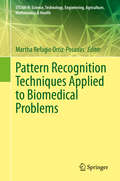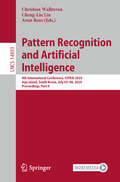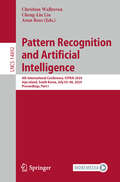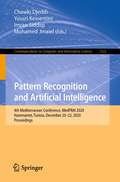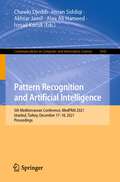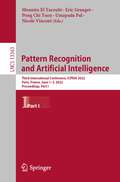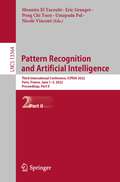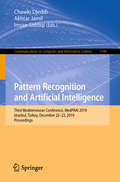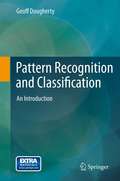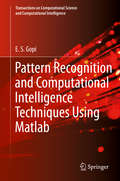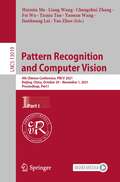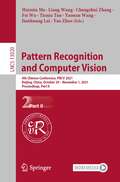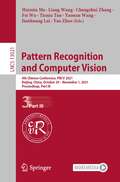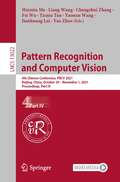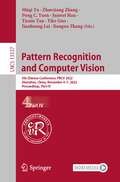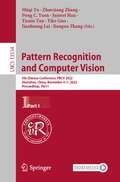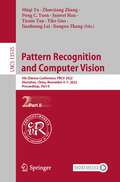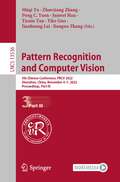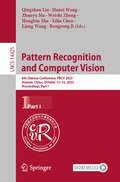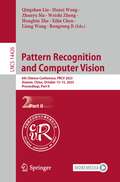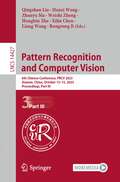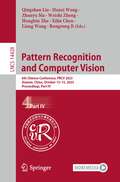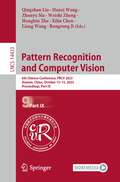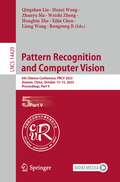- Table View
- List View
Pattern Recognition Techniques Applied to Biomedical Problems (STEAM-H: Science, Technology, Engineering, Agriculture, Mathematics & Health)
by Martha Refugio Ortiz-PosadasThis book covers pattern recognition techniques applied to various areas of biomedicine, including disease diagnosis and prognosis, and several problems of classification, with a special focus on—but not limited to—pattern recognition modeling of biomedical signals and images. Multidisciplinary by definition, the book’s topic blends computing, mathematics and other technical sciences towards the development of computational tools and methodologies that can be applied to pattern recognition processes. In this work, the efficacy of such methods and techniques for processing medical information is analyzed and compared, and auxiliary criteria for determining the correct diagnosis and treatment strategies are recommended and applied. Researchers in applied mathematics, the computer sciences, engineering and related fields with a focus on medical applications will benefit from this book, as well as professionals with a special interest in state-of-the-art pattern recognition techniques as applied to biomedicine.
Pattern Recognition and Artificial Intelligence: 4th International Conference, ICPRAI 2024, Jeju Island, South Korea, July 03-06, 2024, Proceedings, Part II (Lecture Notes in Computer Science #14893)
by Cheng-Lin Liu Arun Ross Christian WallravenThis volume constitutes the refereed proceedings of the 4th International Conference on Pattern Recognition and Artificial Intelligence, ICPRAI 2024, held in Jeju Island, South Korea, during July 03-06, 2024. The 69 full papers presented together with 08 short papers were carefully reviewed and selected from a total of 135 submissions. The conference focuses on topics that includes advanced deep learning approaches for image and document processing, generative AI, novel analysis methods for medical data, and biometrics.
Pattern Recognition and Artificial Intelligence: 4th International Conference, ICPRAI 2024, Jeju Island, South Korea, South Korea, July 03–06, 2024, Proceedings, Part I (Lecture Notes in Computer Science #14892)
by Cheng-Lin Liu Arun Ross Christian WallravenThis volume constitutes the refereed proceedings of the 4th International Conference on Pattern Recognition and Artificial Intelligence, ICPRAI 2024, held in Jeju Island, South Korea, during July 03-06, 2024. The 69 full papers presented together with 08 short papers were carefully reviewed and selected from a total of 135 submissions. The conference focuses on topics that includes advanced deep learning approaches for image and document processing, generative AI, novel analysis methods for medical data, and biometrics.
Pattern Recognition and Artificial Intelligence: 4th Mediterranean Conference, MedPRAI 2020, Hammamet, Tunisia, December 20–22, 2020, Proceedings (Communications in Computer and Information Science #1322)
by Chawki Djeddi Imran Siddiqi Mohamed Jmaiel Yousri KessentiniThis book constitutes the refereed proceedings of the 4th Mediterranean Conference on Pattern Recognition and Artificial Intelligence, MedPRAI 2020, held in Hammamet, Tunisia, in December 2020. Due to the COVID-19 pandemic the conference was held online.The 24 revised papers presented were thoroughly reviewed and selected from 72 submissions. The papers are covering the topics of recent advancements in different areas of pattern recognition and artificial intelligence, such as statistical, structural and syntactic pattern recognition, machine learning, data mining, neural networks, computer vision, multimedia systems, information retrieval, etc.
Pattern Recognition and Artificial Intelligence: 5th Mediterranean Conference, MedPRAI 2021, Istanbul, Turkey, December 17–18, 2021, Proceedings (Communications in Computer and Information Science #1543)
by Chawki Djeddi Akhtar Jamil Imran Siddiqi Alaa Ali Hameed İsmail KucukThis book constitutes the refereed proceedings of the 5th Mediterranean Conference on Pattern Recognition and Artificial Intelligence, MedPRAI 2021, held in Istanbul, Turkey, in December 2021. Due to the COVID-19 pandemic, MedPRAI 2021 was held fully online.The 28 revised full papers and 4 short papers presented were thoroughly reviewed and selected from 72 submissions. The papers are covering the topics of recent advancements in different areas of pattern recognition and artificial intelligence, such as statistical, structural and syntactic pattern recognition, machine learning, data mining, neural networks, computer vision, multimedia systems, information retrieval, etc.
Pattern Recognition and Artificial Intelligence: International Conference, ICPRAI 2020, Zhongshan, China, October 19–23, 2020, Proceedings (Lecture Notes in Computer Science #12068)
by Farida Cheriet Ching Y. Suen Yue Lu Nicole Vincent Pong Chi Yuen Wei-Shi ZhengThis book constitutes the proceedings of the Second International Conference on Pattern Recognition and Artificial Intelligence, ICPRAI 2020, which took place in Zhongshan, China, in October 2020. The 49 full and 14 short papers presented were carefully reviewed and selected for inclusion in the book. The papers were organized in topical sections as follows: handwriting and text processing; features and classifiers; deep learning; computer vision and image processing; medical imaging and applications; and forensic studies and medical diagnosis.
Pattern Recognition and Artificial Intelligence: Third International Conference, ICPRAI 2022, Paris, France, June 1–3, 2022, Proceedings, Part I (Lecture Notes in Computer Science #13363)
by Eric Granger Nicole Vincent Pong Chi Yuen Umapada Pal Mounîm El YacoubiThis two-volume set constitutes the proceedings of the Third International Conference on Pattern Recognition and Artificial Intelligence, ICPRAI 2022, which took place in Paris, France, in June 2022. The 98 full papers presented were carefully reviewed and selected from 192 submissions. The papers present new advances in the field of pattern recognition and artificial intelligence. They are organized in topical sections as follows: pattern recognition; computer vision; artificial intelligence; big data.
Pattern Recognition and Artificial Intelligence: Third International Conference, ICPRAI 2022, Paris, France, June 1–3, 2022, Proceedings, Part II (Lecture Notes in Computer Science #13364)
by Eric Granger Nicole Vincent Pong Chi Yuen Umapada Pal Mounîm El YacoubiThis two-volume set constitutes the proceedings of the Third International Conference on Pattern Recognition and Artificial Intelligence, ICPRAI 2022, which took place in Paris, France, in June 2022. The 98 full papers presented were carefully reviewed and selected from 192 submissions. The papers present new advances in the field of pattern recognition and artificial intelligence. They are organized in topical sections as follows: pattern recognition; computer vision; artificial intelligence; big data.
Pattern Recognition and Artificial Intelligence: Third Mediterranean Conference, MedPRAI 2019, Istanbul, Turkey, December 22–23, 2019, Proceedings (Communications in Computer and Information Science #1144)
by Chawki Djeddi Akhtar Jamil Imran SiddiqiThis book constitutes the refereed proceedings of the Third Mediterranean Conference on Pattern Recognition and Artificial Intelligence, MedPRAI 2019, held in Istanbul, Turkey, in December 2019.The 18 revised full papers and one short paper presented were carefully selected from 54 submissions. The papers are covering the topics of recent advancements in different areas of pattern recognition and artificial intelligence, such as statistical, structural and syntactic pattern recognition, machine learning, data mining, neural networks, computer vision, multimedia systems, information retrieval, etc.
Pattern Recognition and Classification
by Geoff DoughertyThe use of pattern recognition and classification is fundamental to many of the automated electronic systems in use today. However, despite the existence of a number of notable books in the field, the subject remains very challenging, especially for the beginner. Pattern Recognition and Classification presents a comprehensive introduction to the core concepts involved in automated pattern recognition. It is designed to be accessible to newcomers from varied backgrounds, but it will also be useful to researchers and professionals in image and signal processing and analysis, and in computer vision. Fundamental concepts of supervised and unsupervised classification are presented in an informal, rather than axiomatic, treatment so that the reader can quickly acquire the necessary background for applying the concepts to real problems. More advanced topics, such as semi-supervised classification, combining clustering algorithms and relevance feedback are addressed in the later chapters. This book is suitable for undergraduates and graduates studying pattern recognition and machine learning.
Pattern Recognition and Computational Intelligence Techniques Using Matlab (Transactions on Computational Science and Computational Intelligence)
by E. S. GopiThis book presents the complex topic of using computational intelligence for pattern recognition in a straightforward and applicable way, using Matlab to illustrate topics and concepts. The author covers computational intelligence tools like particle swarm optimization, bacterial foraging, simulated annealing, genetic algorithm, and artificial neural networks. The Matlab based illustrations along with the code are given for every topic. Readers get a quick basic understanding of various pattern recognition techniques using only the required depth in math. The Matlab program and algorithm are given along with the running text, providing clarity and usefulness of the various techniques.Presents pattern recognition and the computational intelligence using Matlab;Includes mixtures of theory, math, and algorithms, letting readers understand the concepts quickly;Outlines an array of classifiers, various regression models, statistical tests and the techniques for pattern recognition using computational intelligence.
Pattern Recognition and Computer Vision: 4th Chinese Conference, PRCV 2021, Beijing, China, October 29 – November 1, 2021, Proceedings, Part I (Lecture Notes in Computer Science #13019)
by Liang Wang Yao Zhao Tieniu Tan Fei Wu Changshui Zhang Huimin Ma Yaonan Wang Jianhuang LaiThe 4-volume set LNCS 13019, 13020, 13021 and 13022 constitutes the refereed proceedings of the 4th Chinese Conference on Pattern Recognition and Computer Vision, PRCV 2021, held in Beijing, China, in October-November 2021. The 201 full papers presented were carefully reviewed and selected from 513 submissions. The papers have been organized in the following topical sections: Object Detection, Tracking and Recognition; Computer Vision, Theories and Applications, Multimedia Processing and Analysis; Low-level Vision and Image Processing; Biomedical Image Processing and Analysis; Machine Learning, Neural Network and Deep Learning, and New Advances in Visual Perception and Understanding.
Pattern Recognition and Computer Vision: 4th Chinese Conference, PRCV 2021, Beijing, China, October 29 – November 1, 2021, Proceedings, Part II (Lecture Notes in Computer Science #13020)
by Liang Wang Yao Zhao Tieniu Tan Fei Wu Changshui Zhang Huimin Ma Yaonan Wang Jianhuang LaiThe 4-volume set LNCS 13019, 13020, 13021 and 13022 constitutes the refereed proceedings of the 4th Chinese Conference on Pattern Recognition and Computer Vision, PRCV 2021, held in Beijing, China, in October-November 2021. The 201 full papers presented were carefully reviewed and selected from 513 submissions. The papers have been organized in the following topical sections: Object Detection, Tracking and Recognition; Computer Vision, Theories and Applications, Multimedia Processing and Analysis; Low-level Vision and Image Processing; Biomedical Image Processing and Analysis; Machine Learning, Neural Network and Deep Learning, and New Advances in Visual Perception and Understanding.
Pattern Recognition and Computer Vision: 4th Chinese Conference, PRCV 2021, Beijing, China, October 29 – November 1, 2021, Proceedings, Part III (Lecture Notes in Computer Science #13021)
by Liang Wang Yao Zhao Tieniu Tan Fei Wu Changshui Zhang Huimin Ma Yaonan Wang Jianhuang LaiThe 4-volume set LNCS 13019, 13020, 13021 and 13022 constitutes the refereed proceedings of the 4th Chinese Conference on Pattern Recognition and Computer Vision, PRCV 2021, held in Beijing, China, in October-November 2021. The 201 full papers presented were carefully reviewed and selected from 513 submissions. The papers have been organized in the following topical sections: Object Detection, Tracking and Recognition; Computer Vision, Theories and Applications, Multimedia Processing and Analysis; Low-level Vision and Image Processing; Biomedical Image Processing and Analysis; Machine Learning, Neural Network and Deep Learning, and New Advances in Visual Perception and Understanding.
Pattern Recognition and Computer Vision: 4th Chinese Conference, PRCV 2021, Beijing, China, October 29 – November 1, 2021, Proceedings, Part IV (Lecture Notes in Computer Science #13022)
by Liang Wang Yao Zhao Tieniu Tan Fei Wu Changshui Zhang Huimin Ma Yaonan Wang Jianhuang LaiThe 4-volume set LNCS 13019, 13020, 13021 and 13022 constitutes the refereed proceedings of the 4th Chinese Conference on Pattern Recognition and Computer Vision, PRCV 2021, held in Beijing, China, in October-November 2021. The 201 full papers presented were carefully reviewed and selected from 513 submissions. The papers have been organized in the following topical sections: Object Detection, Tracking and Recognition; Computer Vision, Theories and Applications, Multimedia Processing and Analysis; Low-level Vision and Image Processing; Biomedical Image Processing and Analysis; Machine Learning, Neural Network and Deep Learning, and New Advances in Visual Perception and Understanding.
Pattern Recognition and Computer Vision: 5th Chinese Conference, PRCV 2022, Shenzhen, China, November 4–7, 2022, 2022, Proceedings, Part IV (Lecture Notes in Computer Science #13537)
by Tieniu Tan Zhaoxiang Zhang Shiqi Yu Jianguo Zhang Yike Guo Jianhuang Lai Pong C. Yuen Junwei HanThe 4-volume set LNCS 13534, 13535, 13536 and 13537 constitutes the refereed proceedings of the 5th Chinese Conference on Pattern Recognition and Computer Vision, PRCV 2022, held in Shenzhen, China, in November 2022.The 233 full papers presented were carefully reviewed and selected from 564 submissions. The papers have been organized in the following topical sections: Theories and Feature Extraction; Machine learning, Multimedia and Multimodal; Optimization and Neural Network and Deep Learning; Biomedical Image Processing and Analysis; Pattern Classification and Clustering; 3D Computer Vision and Reconstruction, Robots and Autonomous Driving; Recognition, Remote Sensing; Vision Analysis and Understanding; Image Processing and Low-level Vision; Object Detection, Segmentation and Tracking.
Pattern Recognition and Computer Vision: 5th Chinese Conference, PRCV 2022, Shenzhen, China, November 4–7, 2022, Proceedings, Part I (Lecture Notes in Computer Science #13534)
by Tieniu Tan Zhaoxiang Zhang Shiqi Yu Jianguo Zhang Yike Guo Jianhuang Lai Pong C. Yuen Junwei HanThe 4-volume set LNCS 13534, 13535, 13536 and 13537 constitutes the refereed proceedings of the 5th Chinese Conference on Pattern Recognition and Computer Vision, PRCV 2022, held in Shenzhen, China, in November 2022.The 233 full papers presented were carefully reviewed and selected from 564 submissions. The papers have been organized in the following topical sections: Theories and Feature Extraction; Machine learning, Multimedia and Multimodal; Optimization and Neural Network and Deep Learning; Biomedical Image Processing and Analysis; Pattern Classification and Clustering; 3D Computer Vision and Reconstruction, Robots and Autonomous Driving; Recognition, Remote Sensing; Vision Analysis and Understanding; Image Processing and Low-level Vision; Object Detection, Segmentation and Tracking.
Pattern Recognition and Computer Vision: 5th Chinese Conference, PRCV 2022, Shenzhen, China, November 4–7, 2022, Proceedings, Part II (Lecture Notes in Computer Science #13535)
by Tieniu Tan Zhaoxiang Zhang Shiqi Yu Jianguo Zhang Yike Guo Jianhuang Lai Pong C. Yuen Junwei HanThe 4-volume set LNCS 13534, 13535, 13536 and 13537 constitutes the refereed proceedings of the 5th Chinese Conference on Pattern Recognition and Computer Vision, PRCV 2022, held in Shenzhen, China, in November 2022.The 233 full papers presented were carefully reviewed and selected from 564 submissions. The papers have been organized in the following topical sections: Theories and Feature Extraction; Machine learning, Multimedia and Multimodal; Optimization and Neural Network and Deep Learning; Biomedical Image Processing and Analysis; Pattern Classification and Clustering; 3D Computer Vision and Reconstruction, Robots and Autonomous Driving; Recognition, Remote Sensing; Vision Analysis and Understanding; Image Processing and Low-level Vision; Object Detection, Segmentation and Tracking.
Pattern Recognition and Computer Vision: 5th Chinese Conference, PRCV 2022, Shenzhen, China, November 4–7, 2022, Proceedings, Part III (Lecture Notes in Computer Science #13536)
by Tieniu Tan Zhaoxiang Zhang Shiqi Yu Jianguo Zhang Yike Guo Jianhuang Lai Pong C. Yuen Junwei HanThe 4-volume set LNCS 13534, 13535, 13536 and 13537 constitutes the refereed proceedings of the 5th Chinese Conference on Pattern Recognition and Computer Vision, PRCV 2022, held in Shenzhen, China, in November 2022.The 233 full papers presented were carefully reviewed and selected from 564 submissions. The papers have been organized in the following topical sections: Theories and Feature Extraction; Machine learning, Multimedia and Multimodal; Optimization and Neural Network and Deep Learning; Biomedical Image Processing and Analysis; Pattern Classification and Clustering; 3D Computer Vision and Reconstruction, Robots and Autonomous Driving; Recognition, Remote Sensing; Vision Analysis and Understanding; Image Processing and Low-level Vision; Object Detection, Segmentation and Tracking.
Pattern Recognition and Computer Vision: 6th Chinese Conference, PRCV 2023, Xiamen, China, October 13–15, 2023, Proceedings, Part I (Lecture Notes in Computer Science #14425)
by Liang Wang Qingshan Liu Weishi Zheng Xilin Chen Hongbin Zha Rongrong Ji Hanzi Wang Zhanyu MaThe 13-volume set LNCS 14425-14437 constitutes the refereed proceedings of the 6th Chinese Conference on Pattern Recognition and Computer Vision, PRCV 2023, held in Xiamen, China, during October 13–15, 2023. The 532 full papers presented in these volumes were selected from 1420 submissions. The papers have been organized in the following topical sections: Action Recognition, Multi-Modal Information Processing, 3D Vision and Reconstruction, Character Recognition, Fundamental Theory of Computer Vision, Machine Learning, Vision Problems in Robotics, Autonomous Driving, Pattern Classification and Cluster Analysis, Performance Evaluation and Benchmarks, Remote Sensing Image Interpretation, Biometric Recognition, Face Recognition and Pose Recognition, Structural Pattern Recognition, Computational Photography, Sensing and Display Technology, Video Analysis and Understanding, Vision Applications and Systems, Document Analysis and Recognition, Feature Extraction and Feature Selection, Multimedia Analysis and Reasoning, Optimization and Learning methods, Neural Network and Deep Learning, Low-Level Vision and Image Processing, Object Detection, Tracking and Identification, Medical Image Processing and Analysis.
Pattern Recognition and Computer Vision: 6th Chinese Conference, PRCV 2023, Xiamen, China, October 13–15, 2023, Proceedings, Part II (Lecture Notes in Computer Science #14426)
by Liang Wang Qingshan Liu Weishi Zheng Xilin Chen Hongbin Zha Rongrong Ji Hanzi Wang Zhanyu MaThe 13-volume set LNCS 14425-14437 constitutes the refereed proceedings of the 6th Chinese Conference on Pattern Recognition and Computer Vision, PRCV 2023, held in Xiamen, China, during October 13–15, 2023. The 532 full papers presented in these volumes were selected from 1420 submissions. The papers have been organized in the following topical sections: Action Recognition, Multi-Modal Information Processing, 3D Vision and Reconstruction, Character Recognition, Fundamental Theory of Computer Vision, Machine Learning, Vision Problems in Robotics, Autonomous Driving, Pattern Classification and Cluster Analysis, Performance Evaluation and Benchmarks, Remote Sensing Image Interpretation, Biometric Recognition, Face Recognition and Pose Recognition, Structural Pattern Recognition, Computational Photography, Sensing and Display Technology, Video Analysis and Understanding, Vision Applications and Systems, Document Analysis and Recognition, Feature Extraction and Feature Selection, Multimedia Analysis and Reasoning, Optimization and Learning methods, Neural Network and Deep Learning, Low-Level Vision and Image Processing, Object Detection, Tracking and Identification, Medical Image Processing and Analysis.
Pattern Recognition and Computer Vision: 6th Chinese Conference, PRCV 2023, Xiamen, China, October 13–15, 2023, Proceedings, Part III (Lecture Notes in Computer Science #14427)
by Liang Wang Qingshan Liu Weishi Zheng Xilin Chen Hongbin Zha Rongrong Ji Hanzi Wang Zhanyu MaThe 13-volume set LNCS 14425-14437 constitutes the refereed proceedings of the 6th Chinese Conference on Pattern Recognition and Computer Vision, PRCV 2023, held in Xiamen, China, during October 13–15, 2023. The 532 full papers presented in these volumes were selected from 1420 submissions. The papers have been organized in the following topical sections: Action Recognition, Multi-Modal Information Processing, 3D Vision and Reconstruction, Character Recognition, Fundamental Theory of Computer Vision, Machine Learning, Vision Problems in Robotics, Autonomous Driving, Pattern Classification and Cluster Analysis, Performance Evaluation and Benchmarks, Remote Sensing Image Interpretation, Biometric Recognition, Face Recognition and Pose Recognition, Structural Pattern Recognition, Computational Photography, Sensing and Display Technology, Video Analysis and Understanding, Vision Applications and Systems, Document Analysis and Recognition, Feature Extraction and Feature Selection, Multimedia Analysis and Reasoning, Optimization and Learning methods, Neural Network and Deep Learning, Low-Level Vision and Image Processing, Object Detection, Tracking and Identification, Medical Image Processing and Analysis.
Pattern Recognition and Computer Vision: 6th Chinese Conference, PRCV 2023, Xiamen, China, October 13–15, 2023, Proceedings, Part IV (Lecture Notes in Computer Science #14428)
by Liang Wang Qingshan Liu Weishi Zheng Xilin Chen Hongbin Zha Rongrong Ji Hanzi Wang Zhanyu MaThe 13-volume set LNCS 14425-14437 constitutes the refereed proceedings of the 6th Chinese Conference on Pattern Recognition and Computer Vision, PRCV 2023, held in Xiamen, China, during October 13–15, 2023. The 532 full papers presented in these volumes were selected from 1420 submissions. The papers have been organized in the following topical sections: Action Recognition, Multi-Modal Information Processing, 3D Vision and Reconstruction, Character Recognition, Fundamental Theory of Computer Vision, Machine Learning, Vision Problems in Robotics, Autonomous Driving, Pattern Classification and Cluster Analysis, Performance Evaluation and Benchmarks, Remote Sensing Image Interpretation, Biometric Recognition, Face Recognition and Pose Recognition, Structural Pattern Recognition, Computational Photography, Sensing and Display Technology, Video Analysis and Understanding, Vision Applications and Systems, Document Analysis and Recognition, Feature Extraction and Feature Selection, Multimedia Analysis and Reasoning, Optimization and Learning methods, Neural Network and Deep Learning, Low-Level Vision and Image Processing, Object Detection, Tracking and Identification, Medical Image Processing and Analysis
Pattern Recognition and Computer Vision: 6th Chinese Conference, PRCV 2023, Xiamen, China, October 13–15, 2023, Proceedings, Part IX (Lecture Notes in Computer Science #14433)
by Liang Wang Qingshan Liu Weishi Zheng Xilin Chen Hongbin Zha Rongrong Ji Hanzi Wang Zhanyu MaThe 13-volume set LNCS 14425-14437 constitutes the refereed proceedings of the 6th Chinese Conference on Pattern Recognition and Computer Vision, PRCV 2023, held in Xiamen, China, during October 13–15, 2023. The 532 full papers presented in these volumes were selected from 1420 submissions. The papers have been organized in the following topical sections: Action Recognition, Multi-Modal Information Processing, 3D Vision and Reconstruction, Character Recognition, Fundamental Theory of Computer Vision, Machine Learning, Vision Problems in Robotics, Autonomous Driving, Pattern Classification and Cluster Analysis, Performance Evaluation and Benchmarks, Remote Sensing Image Interpretation, Biometric Recognition, Face Recognition and Pose Recognition, Structural Pattern Recognition, Computational Photography, Sensing and Display Technology, Video Analysis and Understanding, Vision Applications and Systems, Document Analysis and Recognition, Feature Extraction and Feature Selection, Multimedia Analysis and Reasoning, Optimization and Learning methods, Neural Network and Deep Learning, Low-Level Vision and Image Processing, Object Detection, Tracking and Identification, Medical Image Processing and Analysis.
Pattern Recognition and Computer Vision: 6th Chinese Conference, PRCV 2023, Xiamen, China, October 13–15, 2023, Proceedings, Part V (Lecture Notes in Computer Science #14429)
by Liang Wang Qingshan Liu Weishi Zheng Xilin Chen Hongbin Zha Rongrong Ji Hanzi Wang Zhanyu MaThe 13-volume set LNCS 14425-14437 constitutes the refereed proceedings of the 6th Chinese Conference on Pattern Recognition and Computer Vision, PRCV 2023, held in Xiamen, China, during October 13–15, 2023. The 532 full papers presented in these volumes were selected from 1420 submissions. The papers have been organized in the following topical sections: Action Recognition, Multi-Modal Information Processing, 3D Vision and Reconstruction, Character Recognition, Fundamental Theory of Computer Vision, Machine Learning, Vision Problems in Robotics, Autonomous Driving, Pattern Classification and Cluster Analysis, Performance Evaluation and Benchmarks, Remote Sensing Image Interpretation, Biometric Recognition, Face Recognition and Pose Recognition, Structural Pattern Recognition, Computational Photography, Sensing and Display Technology, Video Analysis and Understanding, Vision Applications and Systems, Document Analysis and Recognition, Feature Extraction and Feature Selection, Multimedia Analysis and Reasoning, Optimization and Learning methods, Neural Network and Deep Learning, Low-Level Vision and Image Processing, Object Detection, Tracking and Identification, Medical Image Processing and Analysis.
